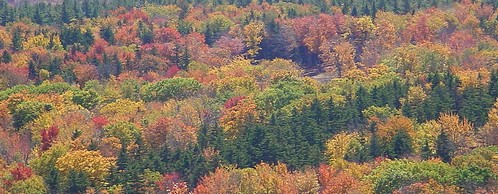Reliving my 1983 Colorado River Experience
Recently, I have been coming across various forms of media talking about the Grand Canyon. This includes the cover story from National Geographic Magazine, a story about Colorado River sediments from a travel magazine, and a Naked Planet documentary on PBS. The Canyon is geology’s best story, ever. Thanks to the power and tenacity of the Colorado River, a visitor to the Canyon gets to see some of the oldest formations on the Earth.
During the twentieth century, man has taken steps to attempt to tame the forceful Colorado by building dams. The two dams that bracket the Grand Canyon are the Glen Canyon dam, built in the ‘50s and early ’60, and Hoover Dam, built earlier from Roosevelt’s programs to help deliver the U.S. from the Great Depression. It’s the Glen Canyon Dam that I give focus to today.
About a year and a half ago at my library’s staff inservice, our branch manager asked us to stand up and say something about ourselves that would not be normally known otherwise. My hidden secret was I rafted through the Grand Canyon as a seventeen-year-old in 1983…..but that was only part of the tale. I rafted through the Grand Canyon during the great canyon flood of 1983.
My uncle and his three sons picked me up late night at the Flagstaff, AZ airport in June 1983. My uncle was alumni at Wooster College in Wooster, OH (as was my mom) and through his connections was able to schedule this 10-day rafting trip with a rafting excursion company via Wooster’s geology professor who went on these rafting trips yearly. On the way to the KOA campground, my uncle and sons talked about their visit to the Glen Canyon Dam, which is above the Grand Canyon and discussed in wonderment about the large discharge of water coming from the dam. The El Nino weather pattern had a pronounced result on the Rocky Mountains that year producing 210 percent of the annual snowfall average. Yes, I said 210 percent.
As a result, water was in danger of flowing over the Glen Canyon Dam wall in addition to going through the dam’s normal intake-outflow pathways. But still the water was coming. The unusually warm weather melted the snow faster than what the dam could contain. As a result, the engineers had to open the dam’s two bypass tubes. To put this into perspective, on a normal precipitation year, the Glen Canyon Dam releases about 2,700 cfs (cubic-feet-per-second) of water. When my uncle and cousins saw the dam, it was releasing 70,000 cfs. And, of course, the Colorado River rose 25 feet above flood stage with the increasing water.
Our raft trip would go on as scheduled. The Wooster professor prepared us for the fact that some of the rapids in the river would be smoothed out because of the flooding and that some of the rapids would be more violent. The trip started off without major event. The river took us into the canyon, its walls going higher for every mile rafted down the river. During the second day, we rafted up the Little Colorado River and spent the afternoon swimming and hiking and getting better acquainted with some of our travel mates (about 60 people in our group). The Little Colorado River was a memorable day for two reasons. First, we got to swim, cliff dive, and frolic in the LCR’s cobalt blue waters. But second, after our fun and return to the main Colorado, a helicopter flew overhead a dropped a bottled message to our lead boat.
The message had two parts. First, a man was killed trying to kayak through Crystal Falls Rapids, which we were to encounter on the next day. And second, the engineers were still having trouble with the large amount water at Glen Canyon Dam and they had no choice but to release an additional 29,000 cfs of water into the canyon meaning the river would rise another twenty feet. Wow! 99.000 cfs. Imagine the discharge of water coming out of that dam!
The decision was made by the captains of each baloney boat in our group that all rafting guests would portage (or walk) around the Crystal Falls while the boat drivers went through the Falls. We were lucky in the fact that there was a large sand bar not destroyed by the rising river. Everyone had their cameras out as we attempted to get pictures of the boats negotiating the gigantic waves of Crystal Falls.
Even though the river was now considered flooded, we still managed to take some of the day hikes that the rafting company had planned for us. This included a trip up Havasu Creek close to where the Havasupi Indians dwelled. But, the three main boat drivers still looked tense as we continued down the river. There was still one major rapid we had to negotiate: Lava Falls Rapids. And this time there was no portaging around it.
Lava Falls is the most violent rapid in the Grand Canyon. And the rising waters of the Colorado River did nothing to quell the violent rapids. Going through the rapids means a dramatic drop of eighty feet in quite a short time. As a rafter goes through the rapids, he or she must avoid the rocks that are hidden by the raging waters.
I was on the second boat to go through the falls. By all indications, the first boat went through without incident. We went through enduring the onslaught of water (image getting into a water fight where you have a thimble of water and your opponent has the world’s largest fire hose) and the baloney boat going through its gyrations as it adjusted to the contours of the rapids.
The members of the third and last boat were not so lucky. Three members of that boat were bucked off into the river. Two of the members were easily retrieved after the boat cleared the rapids. But the third person, a gentleman in his mid 30’s, was caught by the river’s undertow for two minutes and I’m guessing for him it seemed like an eternity. When the boat finally retrieved him, he had water in his lungs. Fortunately, two ladies in our rafting party were fully qualified and capable nurses. We stopped at our planned post Lave Falls rendezvous where the nurses were able to give first aid. The amazing thing that I’ll always remember about this gentleman is the fact that when he was in the water, he clutched tightly to the sunglasses he was wearing and when the boat pulled him from the river he was still clutching his sunglasses—still intact after this dramatic experience.
The rest of the trip went without incident. When we made Lake Mead, we tied the boats together and enjoyed about three hours worth of sunbathing. When we arrived at the end of the boat trip, the respective boat captains broke out into a makeshift game of baseball using paddles as the bats and fresh fruit as the baseballs, obliterating an apple or orange upon successful contact. No doubt they were looking for a release of tension after this arduous journey.
I “Googled” “Glen Canyon Dam” and “dam water discharge” to see if there have been other years since 1983 where the water discharge was phenomenal. Nothing. As it turned out, 1983 was a freak year for the Colorado River and the Grand Canyon. And I was in the right place and the right time to experience it.




0 Comments:
Post a Comment
<< Home